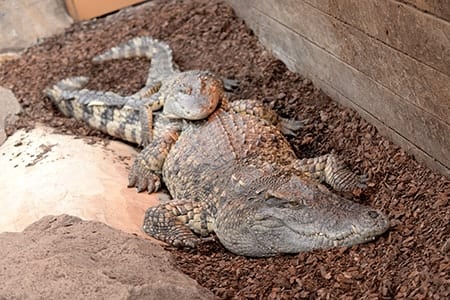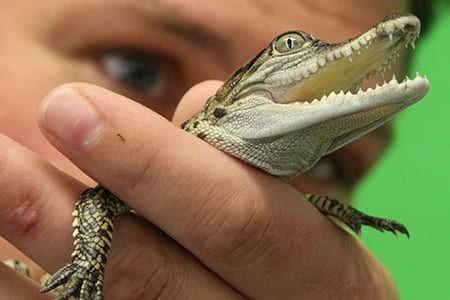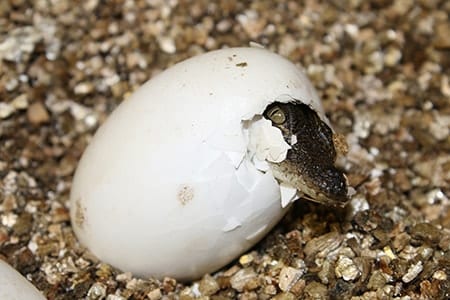Our Driving Purpose
At Crocodiles of the World, we educate people about crocodiles.
We provide engaging experiences with animals and create and share knowledge to promote awareness and conservation. We serve as a visitor’s centre, where people can learn about crocodiles and get a close view of the world’s most effective predators in complete safety.
Whether through interaction with animals or through creating engaging educational experiences, we hope that we can immediately dispel any notion of crocodiles as being “menacing” slow and sluggish animals and spark visitor interest and curiosity.
Indeed, we remind people that if Earth’s history were condensed into just 24 hours, life would have appeared at around 4:00 am, crocodiles at 10:40 pm, dinosaur extinction at 11:41 pm, and human history would have began at 11:58:43 pm.
We also strive to inspire people to make a big difference and support our on-going conservation work and the on-going conservation projects of partner organisations.


Our Achievements
We have listed below a few of our greatest achievements to date.
- 2011, we opened the UK’s first and only crocodile zoo
- 2013, successfully bred American alligators (parents – Albert and Daisy)
- 2014, became the first UK zoo to breed the ‘Critically Endangered’ Siamese crocodile (from parents Hugo and Rebecca)
- 2015, opened a new Mammal and Education area including Meerkats, Otters, Cotton-top tamarins and Kookaburras
- 2016, approved to be one of only five zoos in the UK to participate in the EAZA EEP for Komodo dragons. The species is listed as ‘Vulnerable’ in the wild, making Batu a very welcome addition and we support the Komodo Survival Program based in Indonesia.
- 2017, our Fishing Cat, Freddie, arrived at the zoo. This species is also ‘Vulnerable’.
- 2017, we became the first UK zoo to breed Tomistoma, another ‘Vulnerable’ species of croc.
- 2018, saw our giant Galapagos Tortoises go on show, including Dirk – who at 73 is the largest giant tortoise in the UK. This was part of our unique Chelonia section, displaying a variety of turtle and tortoise species, along with a few other reptile species.
- 2019, built a unique Chinese alligator breeding facility to do our bit for the survival of this Critically Endangered species.
- 2019, we became home to 19 species of crocodilians – by far the largest collection in the UK and one of just a handful of zoos worldwide to house this many species.
Along the way, we’ve continued contributing to conservation projects around the world, become a fully-accredited BIAZA zoo, and some of our staff are key figures in several of the BIAZA committees.
Conservation of the world’s crocodilians:
Threats to wild crocodilians today
The major threats crocodilians in the wild face is the loss, destruction or degradation of habitat. In the past, the unregulated (that is, uncontrolled) hunting of crocs for their valuable skins was the prime concern for their survival. Now, this isn’t any particular concern except in very few cases (if you’re wondering about the crocodile skin products you still see available, these come from registered farms and most of these farms contribute to crocodile conservation – read more here). However, for some species and in some areas, the crocodile populations had not recovered from the hunting of the 1900s, so when habitat loss became an issue it just makes the recovery of those populations that bit harder. For those, the remaining populations are small and spread out into small pockets of habitat. We call these populations ‘fragmented’ since there are no connections between these isolated populations.
Habitat loss can be from:
- Logging
- Siltation of rivers
- Drainage of wetlands
- Dredging of coastal wetlands
- Sand-mining along rivers
- Dams and barrages
- River diversion and water extraction for agriculture
- General urban development
- Pollution from human activities (far too numerous to mention!)
- Conversion of forest to agricultural land
- Use of river banks for human activities
Other threats include:
- Fishing (sometimes crocs are killed by fishermen out of fear; also crocs can be entangled in fishing nets and drown or get killed as a nuisance to fishermen). Some people use explosives to fish, and this can kill or disturb crocodiles – along with everything else in the water! Some fishermen use poisons that can also affect crocs.
- Illegal killing still occurs across the world, but rarely at a scale that threatens a species. In West and Central Africa, the bushmeat trade does see especially dwarf crocodiles threatened by over harvesting the species for use in the bushmeat markets within the region.
- Hybridisation is when two separate species mate successfully together. The result can be the slow genetic erosion of one of the species. This is happening within Cuba between the Cuban crocodile and the larger American crocodile. Pure Cuban crocodiles can be rare in some areas. Usually the instigating factor is the deterioration of the habitat of one species, causing them to move into the range of the other species.
- Invasive species can cause problems. This can be from invasive plants, some of which constrict waterways and reduce prey food abundance for the crocs in the area. Southern Florida is an example where invasive species are breeding out of control. Young American alligators struggle to co-exist with some very large invasive python species.
Current Status
As of early 2022, seven crocodilian species are Critically Endangered:
- Philippine crocodiles
- Chinese alligators
- Gharials
- Siamese crocodiles
- Orinoco crocodiles
- African slender-snouted crocodiles
- Cuban crocodiles
Four species are listed as Vulnerable:
- Tomistoma
- American crocodiles
- Mugger crocodile
- Dwarf crocodile
Those highlighted are species we house here at Crocodiles of the World.
The remainder are Lower Risk, considered to have either extensive population numbers, range or both.
This represents a vast improvement since the early 1970s, when most crocodilian species were endangered or at least significantly reduced in numbers.
See our Foundation page to discover how we are directly contributing to crocodile conservation.


